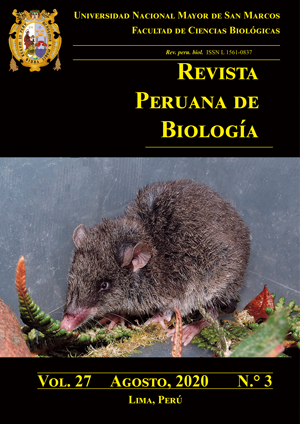Taxonomical revision of the genus Hypseocharis in Peru and Bolivia
DOI:
https://doi.org/10.15381/rpb.v27i3.17598Keywords:
Hypseocharis, Andes, endemic, synonyms, taxonomyAbstract
In the present study we revised the genus Hypseocharis in Bolivia and Peru. A total number of 105 herbarium specimens were revised to evaluate the morphological diversity across the range of the genus. In a subset of 24 complete individuals a multivariate morphometric analysis was performed to evaluate the morphological characters historically used to differentiate the “species” of the genus Hypseocharis. A revision of the herbarium material indicated that there are no sharp lines dividing the different “species” with the only exception of H. tridentata. The multivariate analysis indicated that H. bilobata, H. malpasensis and H. pedicularifolia all occupy the same morphospace as H. pimpinellifolia and there are no individual morphological characters or suites of characters permitting the differentiation of distinct taxa. This confirms earlier findings from Argentina: There are only two species in the genus, widespread Hypseocharis pimpinellifolia and H. tridentata. Hypseocharis pilgeri, originally described from Peru, can also not be differentiated from H. pimpinellifolia. We propose the recognition of only two species: H. pimpinellifolia with variously pinnate to bipinnate leaves with a terminal leaflet at most marginally larger than the lateral ones, flowers with 15 anthers and capsular fruits as differing from H. tridentata with pinnate leaves with the terminal leaflet much larger than the lateral ones, flowers with 5 anthers and schizocarpic fruits. Hypseocharis pimpinellifolia is a widespread and polymorphic species, ranging from Ancash (Peru) to La Rioja (Argentina) and comprises forms with white, yellow, orange, and red corollas and with simply pinnate to very finely bipinnate leaves.
Downloads
Downloads
Published
Issue
Section
License
Copyright (c) 2020 Sissi Lozada-Gobilard, Sergio Avila-Calero, Teresa Ortuno, Maximilian Weigend

This work is licensed under a Creative Commons Attribution-NonCommercial-ShareAlike 4.0 International License.
AUTHORS RETAIN THEIR RIGHTS:
a. Authors retain their trade mark rights and patent, and also on any process or procedure described in the article.
b. Authors retain their right to share, copy, distribute, perform and publicly communicate their article (eg, to place their article in an institutional repository or publish it in a book), with an acknowledgment of its initial publication in the Revista Peruana de Biologia.
c. Authors retain theirs right to make a subsequent publication of their work, to use the article or any part thereof (eg a compilation of his papers, lecture notes, thesis, or a book), always indicating its initial publication in the Revista Peruana de Biologia (the originator of the work, journal, volume, number and date).






